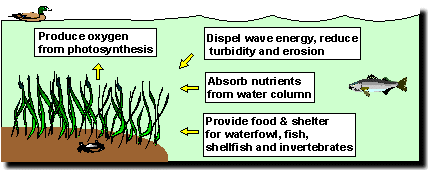Submerged Aquatic Vegetation (SAV)
Main_Content
Importance of Submerged Aquatic Vegetation (SAV)

- Generate food and habitat for waterfowl, fish, shellfish, and invertebrates.
Many components of the plant structure such as seeds, tubers, and even the
leafy vegetation are a major source of food for a variety of organisms around the bay. The leaf and stem structures of bay grasses also provide excellent habitat and nursery sites for species such as killifish and minnows. Softshell crabs are known to seek cover in grass beds during their time of vulnerability.
- Release oxygen. During photosynthesis, plants utilize sunlight and water to convert carbon dioxide (CO2) from the atmosphere into organic material that can be used by the plant. Oxygen, essential to other underwater organisms such as fish, is a byproduct of this process
- Inhibit wave action that erodes shorelines. In healthy bay grass beds, dense plant structures including leaves, stems, reduce water currents and root systems hold bottom sediments in place.
- Remove sediment from the water column. Inhibiting wave action allows bay grasses to filter and trap sediment from the water column that would otherwise bury organisms on the bottom and cloud the water column.
- Absorb excess nutrients. During photosynthesis, Plants utilize sunlight and water to convert carbon dioxide (CO2) from the atmosphere into organic material that can be used by the plant. During photosynthesis plants require the uptake of nutrients, nitrogen and phosphorus in particular, that may fuel the growth of unwanted algae in surrounding water.